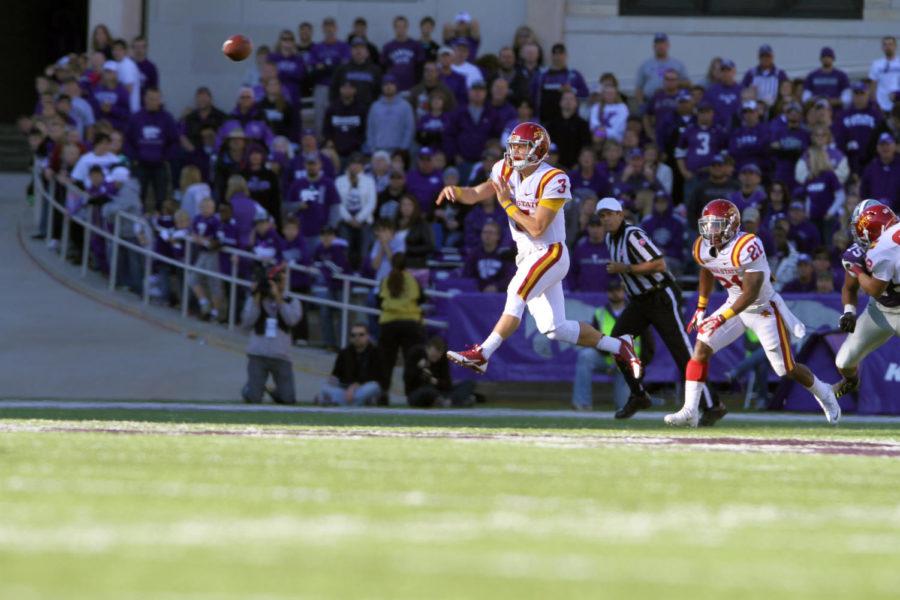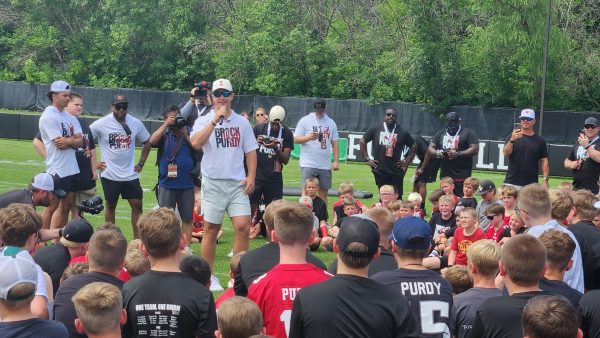NOTEBOOK: Lack of big plays, rushing defense stops ISU football in loss to Kansas State
Iowa State’s quarterback, Grant Rohach, throws the ball after a fourth down by the Wildcats. Rohach had a total of 88 yards in passing but still lost to the Wildcats with a final score of 7-41.
November 2, 2013
MANHATTAN, Kan. — An inability to stop the run and a lack of continuity on offense continued to be the recurring theme in Iowa State’s 41-7 loss to Kansas State on Saturday, Nov. 2.
For the third game in a row, ISU quarterback Grant Rohach relieved starting quarterback Sam Richardson. Before he left the game, Richardson had completed six of his 12 passes for 38 yards and an interception.
What made Iowa State’s head coach decide to switch quarterbacks again?
“Zero points and no finished drives,” Paul Rhoads said after the game.
Rohach entered the game midway through the second quarter, after Richardson had thrown the interception on the previous drive.
Rohach’s first drive led Iowa State to the K-State 29-yard line — the deepest position the team would have before its final drive in the fourth quarter — before the drive ended on a hooked Cole Netten field goal.
Rohach finished the game hitting 11 of 24 passes with two interceptions and 88 yards, while scampering for 20 yards on the ground.
“Same thing it’s always been: We didn’t get in a groove for quite some time,” Rohach said. “Same thing every week, not completing balls when they’re in front of us, not converting third downs, that’ll kill any offense.”
Run defense
Against Bill Snyder’s Wildcats, running the football allowed Kansas State to control the ball averaging 4.7 yards per carry with 227 yards on the ground. Running back John Hubert led Kansas State with 105 yards on 15 carries.
Kansas State switched quarterbacks multiple times throughout the game. After starting with Jake Waters, Kansas State switched to the more run-prone Daniel Sams, both of whom combined for 310 yards running and throwing.
“The designed quarterback run game is hard to defend because they create an extra gap,” Rhoads said. “To get the extra player in there you weaken other areas. They made us pay for those man situations, obviously.”
Lack of big plays
Kansas State played the nation’s No. 1 offense to half of its average point total with 35 in then No. 15 Baylor. When the K-State defense matched up across from Iowa State, it held the Cyclones to 249 yards and took away big plays.
Iowa State’s Quenton Bundrage, through six games, was No. 3 in the Big 12 in touchdown catches with six. In Saturday’s game, Kansas State only allowed Bundrage to one catch for 10 yards.
“Certainly he’s become obvious to folks that he’s our playmaker, so you’re getting coverages designed to double him,” Rhoads said. “We need to do a better job with that knowledge — and with witnessing what they’re doing — of finding ways to get him the ball.”

















